This page introduces our various initiatives for ensuring legal compliance in all our business activities, reducing their environmental impact, and so forth.
Management of Legal Compliance Regarding Environmental Impacts
Basic Policy for Environmental Risk Management
The Advantest Group sets voluntary standards more stringent than prevailing environmental laws and regulations, and implements such standards in the course of operating equipment that could potentially impact the environment, and in monitoring and assessing those operations.
Furthermore, to ensure that we can respond without hesitation should an environment-related incident occur, we have established rules for addressing such risks, stipulated in documented operating procedures and chemical substance emergency-response procedures and other such guidelines, and have put management systems in place related to those rules.
Moreover, our employees and contractors handling particularly high-risk operations regularly take part in specialized training and emergency drills, which are conducted to ensure that they are able to act swiftly in the event of an emergency.
Compliance management at business sites
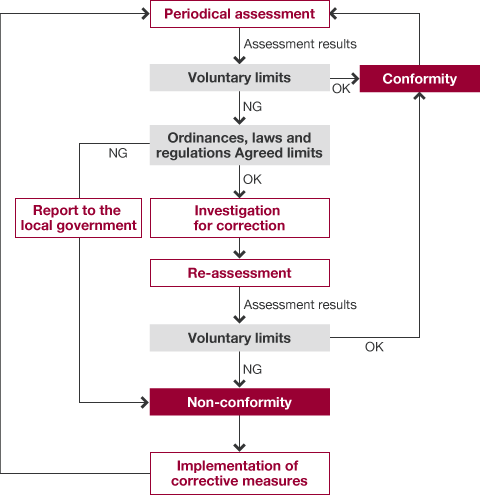
In fiscal 2024, there were no cases which exceeded our voluntary standards for water quality and air quality.
Management of Chemical Substances
Basic Policy for Chemical Substance Management
We are working to ensure safety management and compliance with laws and regulations in the use and storage of chemical substances used at Advantest Group business locations.
To this end, we have adopted a chemical substance management system. This system facilitates chemical substance registration, reviews, input/output control, and the calculation of data required by relevant laws and regulations, as well as making the safety data sheets (SDS) that are necessary for the safe handling of chemical substances available at any time.
In addition, in order to realize strengthened risk management and chemicals substance management, we are constructing a safety training system, and are conducting audits and providing guidance through the corporate chemical management division to ensure the safety of stored chemical substances, so as to further enhance our safety control system.
As described in the section "Compliance with the Environmental Regulations in Each Country," we have established a global legal compliance system for products, quality, and safety. Going forward, we plan to use this system to promote safety management of chemicals (chemical substances) at each company.
Improving Chemical Substance Management: "Aiming for More Precise Management"
At Advantest Group, we manage the chemical substances that we use by container through our chemical substance management system. Based on the chemical substances management level specified under the PRTR Law, the Poisonous and Deleterious Substances Control Law, the Industrial Safety and Health Law and other laws and regulations, we have established a classification system of management ranks and set the management method according to each rank, with the aim of having a flexible system.
Furthermore, in response to the revision of laws and regulations, Advantest built and executed a system for the risk management of chemical substances which had become a requirement as of June 2016.
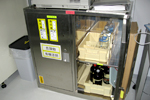
Adopting the High-precision Management Methods in Line with the Different Level of Risks Posed by Different Chemical Substances
We implement training in chemical substance handling for Advantest Group employees, ensuring that employees understand how to handle particular types of chemical substances and are aware of the key points to note regarding their use. Management procedures are simplified for chemical substances that are less hazardous, and autonomous management is implemented with respect to commercially-available sprays, adhesives, etc.
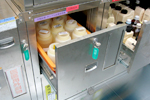
Chemical substance control ranks
In line with this management approach, proper after-use treatment will be followed, such as making a request to a waste treatment company.
Efforts to Address PFAS
Efforts to Eliminate PFAS Coolant in New Products
Advantest is continuously committed to the "development of products that are free from polluting substances". As for the total abolition of PFAS coolant by fiscal 2030, we are moving forward to adopting water as the coolant to be used in next-generation testers. In fiscal 2022, we confirmed the cooling performance and durability of indirect cooling technology using water. New products incorporating this technology were shipped in fiscal 2024.
The Challenges of Supplying PFAS Cooling Fluid
While we aim to eliminate PFAS cooling fluid, we are tasked to address
the challenges of supplying PFAS cooling fluid for our current
models.
To this end, the following measures continue to be taken by working
cross-sectionally throughout the organization.
-
Evaluation of alternatives to PFAS cooling fluid currently in use
-
Procurement risk measures by the Production Group for PFAS cooling fluid
-
*PFAS is not a name of a specific chemical substance, but an acronym for "Per- and PolyFluoroAlkyl Substances".
Efforts to Monitor Emissions
Efforts to Reduce VOC (Volatile Organic Compounds) Emissions
VOC substances are considered as substances that produce photochemical oxidants and suspended particulates. Facilities using a large amount of VOC are obligated by Article 17-13 of the Air Pollution Control Act to monitor VOC emissions into the atmosphere that are attributable to their business activities and take the measures that are necessary to reduce the emissions.
VOC is not used much in the electrical and electronic industry. However, the Ministry of Economy, Trade and Industry has requested companies to take voluntary measures to reduce VOC emissions, as we also cooperated in the survey from 2005 to 2020 representing the four electrical and electronic industry groups (JEMA, CIAJ, JEITA, and JBMIA).
These surveys cover 20 substances that are often used in the electrical and electronic industry. Advantest does not use them in large quantities, but has been conducting surveys on the consumption of these substances and report it as required.
VOC data
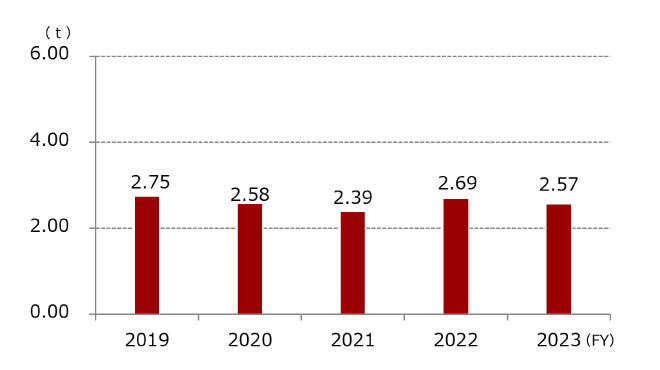
-
*The 20 substances (isopropyl alcohol, toluene, acetone, butyl acetate, methanol, xylene, methyl ethyl ketone,dichloromethane, styrene, ethanol, and others), that account for 95% of the total emissions covered in the status report submitted by the four electrical and electronic industry groups (JEMA, CIAJ, JEITA, and JBMIA) as part of their "Voluntary measures to reduce VOC emissions" requested by the Ministry of Economy, Trade and Industry, are aggregated.
PRTR Report
According to the Law Concerning Pollutant Release and Transfer Register, Advantest has been submitting reports to the government under the Pollutant Release and Transfer Register (PRTR) system.
PRTR data
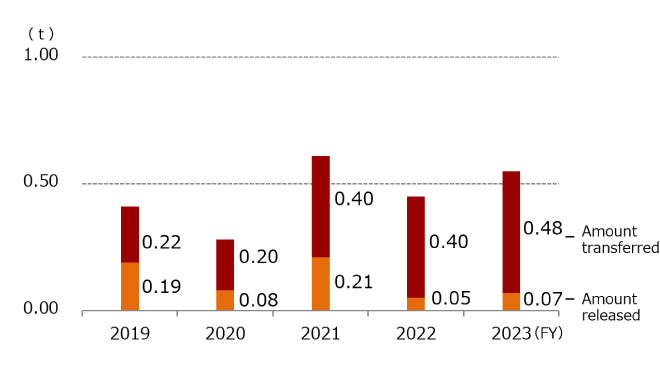
-
*The table includes PRTR controlled substances whose annual amount of use was below the amount required to be reported.
Implementation of General and Specialist Chemical Substance e-learning Education
Used inappropriately, even familiar chemical substances may cause
unexpected accidents and environmental pollution. We provide the
general chemical substance education program to all our domestic
employees in order to help them understand how to reduce such
risks.
The specialist chemical substance education program is
provided to employees who use chemical substances in their daily
work. The purpose of this annual e-learning program is to raise
awareness of the dangers and harmfulness of chemical substances as
well as to promote the safe handling thereof through practical
learning content.
In this program we explain things simply, using examples of
accidents, regarding chemical substances regulated under the main
laws such as poisons, deleterious substances, organic solvents,
specific chemical substances, hazardous materials covered by the
Fire Services Law, etc.
In fiscal 2024, we conducted general education for all newly hired employees in Japan and specialist training for 285 employees who handle chemical substances.
on chemical substances
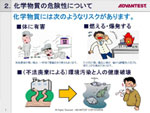
Content
-
The danger of chemical substances (effects on the human body)
-
The importance of safety training for chemical handlers
-
The importance of wearing personal protective equipment (gloves, goggles, masks, etc.)
-
Points to be observed according to the requirements of the law
Special medical diagnosis, selection of a work leader, environmental measurement, inspection of ventilation equipment, notification of designated hazardous materials specified under the Fire Services Law, etc.
Involving Our Business Partners
Green Procurement/Initiatives Related to Regulations for Chemical Substances Contained in Product
At Advantest we are striving to eliminate hazardous substances across our manufacturing activities including suppliers of components and assembly and processing partner companies, and wish to connect this to the development of green products. We engage in communication with our business partners, and formulated the Advantest Green Procurement Guidelines in fiscal 2002 to facilitate this process. We operate according to these guidelines in order to give consideration to the environmental aspects in addition to quality, cost, and delivery throughout the whole process of production, including the purchasing of components and materials that are used for our products. Changes to the guidelines, if any, are notified to our suppliers via the electronic transaction and technical information exchange system (portal site) seeking for their cooperation.
We have created a database from the environmental information we received from our suppliers, and are utilizing it to promote eco-friendly product manufacturing, along with the implementation of product environmental assessments.
Advantest has also concluded the General Specification for the Environment(GSE)* with our suppliers as a contract for the same measures even at overseas bases to eliminate the chemical substances contained in products and to identify substances that need to be reported.
-
*The GSE provides Advantest’s general requirements for restricting or prohibiting certain substances as constituents of parts, components, and materials in products and packaging purchased by Advantest worldwide, including specific reporting and labeling requirements.
The Principles of the Green Procurement
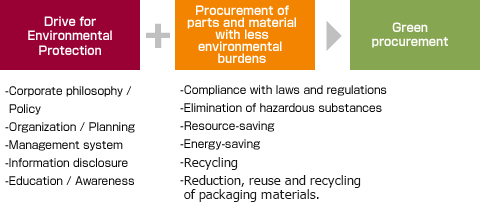
Component Registration in Green Procurement
Regarding component registration, we are conducting environmental surveys for procured components using our environmental survey questionnaire with cooperation from our suppliers, based on the operation standard for chemical substances used in Advantest products. We investigate the components to find out if they contain chemical substances that can burden the environment, and promote green procurement initiatives to reduce environmental impact.
Banned and Restricted Substances
We have established the aforementioned operation standard for chemical substances used in Advantest products based on IEC62474* and use it in surveys on the use of hazardous substances in components used and to determine whether or not to adopt the components.
-
*IEC62474: Material Declaration for Products of and for the Electrotechnical Industry (See: https://std.iec.ch/iec62474)
Survey of Suppliers on Hazardous Substances
Starting with the RoHS Directive, there have recently been additions and revisions to electrical and electronic regulations. In accordance with the revised IEC62474, Advantest has also revised its questionnaire on hazardous substances as needed and informed all suppliers. The survey form is scheduled to be revised by September 2025.
Compliance with the Environmental Regulations in Each Country
In complying with environmental laws and regulations, the Advantest Group is working towards eliminating the use of hazardous materials while also pursuing environmental conservation efforts that involve reducing the consumption of energy and resources. More specifically, we have been working with our suppliers since the autumn 2003 on initiatives to investigate and eliminate the use of restricted hazardous materials. We are in compliance with the European RoHS Directive*.
Collaboration with Overseas Subsidiaries
Advantest has organized a global team among those overseas bases that
have R&D departments (Japan, Germany, USA) since the middle of 2020,
and has built a system to work on compliance with laws and regulations
related to environment, quality, and safety of our products.
Currently, we hold regular global meetings to agree to and unify our
recognition as an Advantest Group. Based on this understanding, each
company of the Advantest Group promotes the drafting and implementation of environmental
law education materials for local engineers according to the product
groups.
Chemical Substances Contained in Product
EU-RoHS
Advantest's semiconductor Test system, Test handler are classified as Large-Scale Stationary Industrial Tools (LSSIT) under the EU-RoHS, and as such are exempt from the directive's provisions. Nevertheless, on the basis of our commitment to environmental conservation, we will continue to work towards continuing elimination of hazardous substances from these product lines.
-
*The European RoHS Directive and its revision stipulate ((EU) 2015/863) restrictions on the use of specified hazardous substances contained in electric and electrical devices in Europe; inclusion of the following substances (10 such substances are used for our products as of July 22, 2021) in excess of the maximum allowed limits is prohibited, except for exempted purposes.
-
Lead (Pb)
-
Hexavalent chromium (Cr VI)
-
Mercury (Hg)
-
Polybrominated biphenyl (PBB)
-
Cadmium (Cd)
-
Polybrominated diphenyl ether (PBDE)
-
Bis phthalate (2-ethylhexyl) (DEHP)
-
Dibutyl phthalate (DBP)
-
Butyl benzyl phthalate (BBP)
-
Diisobutyl phthalate (DIBP)
China RoHS
The China RoHS outlines the following items for selling
products, which contain the same 6 substances set out in the first EU
RoHS directive, within China: (1) identification marks (on the
product) of whether or not it contains specified hazardous substances;
(2) indication of environment-friendly use period (on the product);
(3) description of the type, region, and amount of hazardous
substances contained (in the product manual); (4) labeling of
packaging materials (on the packaging materials themselves); and (5)
year and month of production.
Advantest has established a system to assure that these labels are
reliably displayed in products to be shipped for China.
REACH Regulation
REACH is a regulation of the European Union, which stands for Registration, Evaluation, Authorization and Restriction of Chemicals. REACH places the burden of proof on companies, where they are obliged to register, submit documents, and report on the linked to the substances they manufacture or import in the EU with a total amount of 1 ton or more per year to the European Chemicals Agency. Advantest's products or "molded articles" are exempt from REACH's provisions as said; however, candidates for substances of very high concern (SVHC) must be reported upon request.
Advantest products may contain the following SVHC:
-
Diarsenic pentaoxide
-
Diarsenic trioxide
-
Boric acid
-
Hexavalent chromium compound
-
Cobalt chloride
-
Disodium tetraborate, anhydrous
-
Lead chromate
-
Bis (2-ethylhexyl) phthalate (DEHP)
-
Dibutyl phthalate (DBP)
-
Butyl benzyl phthalate (BBP)
-
Diisobutyl phthalate (DIBP)
-
1,2-Benzenedicarboxylic acid, di-C7-11-branched and linear alkyl esters (DHNUP)
-
Zirconia aluminosilicate, refractory ceramic fibers
-
Trixylyl phosphate (2-chloroethyl) (TCEP)
-
4- (1,1,3,3-tetramethylbutyl) phenol
-
Bis (2-ethylhexyl) phthalate (DEHP)
-
Sulfurous acid, lead salt, dibasic
-
1,2-dimethoxyethane; ethylene glycol dimethyl ether (EGDME)
-
Pentalead tetraoxide sulphate
-
Boric anhydride
-
N,N-dimethylformamide
-
Diisopentyl phthalate (DIPP)
-
N-pentyl-isipentyl phthalate
-
Lead titanate, lead titanium trioxide
-
Lead titanate zirconate
-
Lead oxide sulfate
-
(Phthalato (2-))dioxotrilead
-
Di-n-hexyl phthalate (DnHP)
-
Methylhexahydrophthalic anhydride
-
Cadmium
-
Cadmium oxide
-
Dipentyl phthalate (DPP)
-
4-Nonylphenol, branched and linear, ethoxylated
-
Cadmium sulfide
-
Trixylenyl phosphate
-
Imidazolidine-2-thione, 2-imidazoline-2-thiol
-
10-ethyl-4,4-dioctyl-7-oxo-8-oxa-3,5-dithia-4-stannatetradecanoic acid 2-ethylhexyl (DOTE)
-
2-(2H-benzotriazol-2-yl)-4,6-di-tert-pentylphenol (UV-328)
-
1,2-benzenedicarboxylic acid, di-C6-10-alkyl esters, mixed decyl and hexyl and octyl diesters
-
Benzo[def]chrysene (Benzo[a]pyrene)
-
Dicyclohexyl phthalate (DCHP)
-
4,4'-isopropylidenediphenol (BPA)
-
Perfluorohexanesulfonic acid and its salts
-
Chrysene
-
Benz[a]anthracene
-
1,6,7,8,9,14,15,16,17,17,18,18Dodecachloropentacyclo[12.2.1.16,9.02,13.05,10]octadeca-7,15-diene ("Dechlorane Plus" ™)
-
Octamethylcyclotetrasiloxane (D4)
-
Decamethylcyclopentasiloxane (D5)
-
Dodecamethylcyclohexasiloxane (D6)
-
Terphenyl, hydrogenated
-
Lead
-
2,2-bis(4'-hydroxyphenyl)-4-methylpentane
-
Tris(4-nonylphenyl, branched and linear) phosphite (TNPP) with >= 0.1% w/w of 4-nonylphenol, branched and linear (4-NP)
-
Tetraboron disodium heptaoxide hydrate
-
Perfluorobutanesulfonic acid (PFBS) and its salts
-
Dioctyltin dilaurate, stannane, dioctyl-, bis(cocoacyloxy) derivatives, and any of the other stannane, dioctyl-, bis(fatty acyloxy) derivatives, wherein C12 is the predominant carbon number of the fatty acyloxy moiety
-
4,4'-(1-methylpropylidene)bisphenol
-
Medium-chain chlorinated paraffins (MCCP)
-
4-nonylphenol (branched and linear)
-
6,6'-di-tert-butyl-2,2'-methylenedi-p-cresol
Regarding the California Law "Regulation of Handling Perchlorates"
Businesses who manufacture, distribute, sell, use, dispose of perchlorates (containing 6 ppb perchlorate or more) for resale or use in California, and when exporting to California need to ensure that these perchlorates are properly labeled on their individual packaging boxes and carrier boxes (for shipping packaging). The majority of perchlorates are lithium-ion batteries, which are already labeled on our products.
The following label or mark is necessary
Perchlorate
Material - special handling may apply, See
www.dtsc.ca.gov/hazardouswaste/perchlorate.
The following Advantest products may also contain perchlorate.
Regarding the California Law "Proposition 65"
Proposition 65 is a law that protects the citizens of California from
serious exposure to chemical substances that are known to trigger
cancer, congenital anomalies or reproductive disorders.
The law requires companies and people conducting business in
California to provide clear and reasonable warnings before knowingly
and purposely exposing California's citizens to chemical substances on
the Proposition 65 list.
Although Advantest products may contain chemical substances that are
included in the Proposition 65 list, there is no risk of human
exposure through skin contact, ingestion or inhalation if the products
are used according to Advantest recommendations.
For this reason, Advantest has deemed that a warning label stating
that a product contains chemical substances listed in Proposition 65
is unnecessary.
Based on customer requests, we can offer information on chemical substances included in Advantest products that are listed in Proposition 65.
Furthermore, as there is a risk of exposure to the chemical substances listed in Proposition 65 when handling Advantest products in a way that is not recommended by us, such as destroying or shattering the products, we recommend taking measures such as wearing dust masks, protective gloves, and ventilating to alleviate and reduce any risk of exposure.